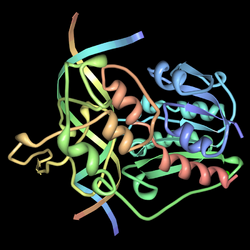Biology:HaeIII
| Type-2 restriction enzyme HaeIII | |||||||
|---|---|---|---|---|---|---|---|
 The crystal structure of HaeIII enzyme convalently complexed to DNA: an extrahelical cytosine and rearranged base pairing. | |||||||
| Identifiers | |||||||
| Organism | |||||||
| Symbol | haeIIIR | ||||||
| RefSeq (Prot) | WP_006996034.1 | ||||||
| UniProt | O68584 | ||||||
| Other data | |||||||
| EC number | 3.1.21.4 | ||||||
| Chromosome | Genomic: 0.7 - 0.7 Mb | ||||||
| |||||||
| HaeIIIR | |||||||||
|---|---|---|---|---|---|---|---|---|---|
| Identifiers | |||||||||
| Symbol | RE_HaeIII | ||||||||
| Pfam | PF09556 | ||||||||
| InterPro | IPR019059 | ||||||||
| |||||||||
HaeIII is one of many restriction enzymes (endonucleases) a type of prokaryotic DNA that protects organisms from unknown, foreign DNA.[1] It is a restriction enzyme used in molecular biology laboratories. It was the third endonuclease to be isolated from the Haemophilus aegyptius bacteria. The enzyme's recognition site—the place where it cuts DNA molecules—is the GGCC nucleotide sequence which means it cleaves DNA at the site 5′-GG/CC-3. The recognition site is usually around 4-8 bps[1].This enzyme's gene has been sequenced and cloned. This is done to make DNA fragments in blunt ends. HaeIII is not effective for single stranded DNA cleavage.
Properties
HaeIII has a molecular weight of 37126. After a 2-10-fold of HaeIII takes place, there is overdigestion of a DNA substrate. This results in 100% being cut, more than 50% of fragments being ligated, and more than 95% being recut. Heat inactivation comes at about 80 °C for 20 minutes. The locus of the HaeIII enzyme is on AF05137, and is linear with 957 base pairs.
History
HaeIII along with other restriction enzymes were discovered in 1970 by Werner Arber and Matthew Meselson. The HaeIII methyltransferase also known as MTase gene from Haemophilus aegyptius (recognition sequence: 5′-GGCC-3′) was made into Escherichia coli (E.coli) in the plasmid vector pBR322. The gene was extracted from a single EcoRI fragment and a single HindIII enzyme fragment. Clones carrying additional adjacent fragments were found to code for the HaeIII restriction enzyme.
Function
The enzyme cleaves the DNA at the positions where the GGCC sequence is found. The cleavage occurs between the second and the third nucleotides (G and C). The resulting DNA fragments are known as restriction fragments. HaeIII cuts both strands of DNA in the same location, yielding restriction fragments with blunt ends. Heat denaturation occurs at 80°C after 20 minutes.[2]
Methylase
Haemophilus aegyptius also carries a methylase dubbed HaeIIIM (P20589) that methylates the internal cytosines in the GGCC sequence. It protects sequences from being cut by HaeIII, and forms a restriction modification system. HaeIII enzyme comes from an E. coli strain that carries the cloned HaeIII modification gene from Haemophilus aegyptius.
References
Further reading
- Rawn, J. David (1989). Biochemistry (International ed.). ISBN 0-89278-405-9.
- "Cloning and analysis of the HaeIII and HaeII methyltransferase genes". Gene 74 (1): 45–50. December 1988. doi:10.1016/0378-1119(88)90248-x. PMID 3248732.
- "Duplex regions in "single-stranded" phiX174 DNA are cleaved by a restriction endonuclease from Haemophilus aegyptius". The Journal of Biological Chemistry 252 (20): 7300–6. October 1977. doi:10.1016/S0021-9258(19)66969-3. PMID 71298.
- "Chromatographic analysis of the chiral and covalent instability of S-adenosyl-L-methionine". Biochemistry 25 (15): 4444–9. July 1986. doi:10.1021/bi00363a041. PMID 3530324.
 |

